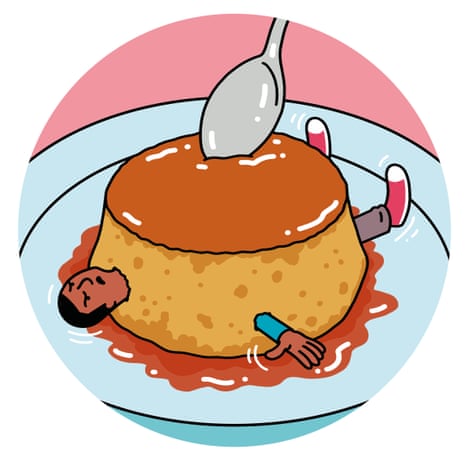To give you an idea of how my attempt to make creme caramel went, here’s a list of my Google searches, before, during and after: “creme caramel recipe”, “cleaning burnt caramel” and “how is creme caramel supposed to taste?” What went wrong? Well, I blame the recipe.
“First,” Delia writes, “make the caramel. Put golden caster sugar in the saucepan and place it over a medium heat and leave it just like that.” There is a crucial word missing here, and that word was “small”. If your saucepan is too large, the whole process will happen too quickly. There are two things that can go wrong. The first is that you can end up with burnt caramel. The second is that the caramel will go hard quicker than you expect, and the bigger the saucepan, the more of a risk that you will end up with a leftover chunk of solid caramel halfway up the pan. You should use your smallest saucepan on your smallest ring.
“Now take the pan off the heat, and add two tablespoons of warm tap water,” says Delia. I’m not quite sure why it is that Delia decided to write this recipe without referring to a kettle at any point, but her preferred option is to use warm water, straight from the tap. As regular readers will know, my kitchen is getting on a bit, and one of the consequences is that to make sure the boiler gets the idea and actually starts producing hot water, you have to turn the hot tap all the way up. Fortunately, you can achieve the same effect by using water from the kettle.
“Stand back as it may splutter a bit at this stage,” Delia advises. The word “may” in fact means “always”. Then “pour into your souffle dish – anything heatproof you can put in an oven will do – and coat the edges with your caramel”. At this point, if you are prone to fretting, you may worry that the sugar is burnt. What I can confirm, having done several run-throughs, is that while – if you have never made caramel before – you may worry that you have simply burnt sugar, once you actually burn some sugar you will never confuse the two again. The good news is that the next part is the easiest: you pour the milk and cream into another pan and leave it to heat gently while you whisk together the eggs, vanilla extract and remaining sugar in a large bowl. Then you add all that to your caramel-lined dish and put that dish in a roasting tin.
I’m not sure who was to blame for what went wrong next. What you are actually supposed to do – and indeed, Delia’s website is very clear on this point – is to pour water (it can be hot or cold) into the roasting tin and let the dish gently float in there. But in my copy of How to Cook, at least, it is not entirely clear whether or not the water should be inside or outside the dish. I flip a coin and add the water into the dish, which turns out to be a catastrophic mistake. The finished product collapses on the plate and leaks. Inadvertently, I have invented a creme caramel-flavoured drink. Once I have decanted the liquid, the unhappy pudding is very rich but so flat as to be one-dimensional, although the flavour holds up surprisingly well. Sighing, I turn to Google once more, and type in the following: “Home delivery dessert”. The resulting pudding is much better.

Comments (…)
Sign in or create your Guardian account to join the discussion